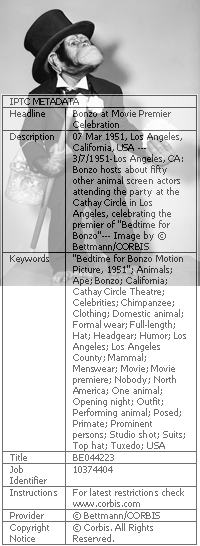Back to Digital Preservation Pioneers
 When you take a digital photo, the camera immediately records information about the aperture setting, shutter speed, focal length, metering mode and more. Some cameras have a global positioning system that adds information about where the photo was taken.
When you take a digital photo, the camera immediately records information about the aperture setting, shutter speed, focal length, metering mode and more. Some cameras have a global positioning system that adds information about where the photo was taken.
But David Riecks (rhymes with "clicks") – professional photographer, digital-image technologist and metadata evangelist – believes that a digital photo should contain more information about itself. And he is on a mission to spread the word about the current and long-term value of photo metadata.
Photography was always a source of income for Riecks. He worked his way through college with a number of photography jobs, including working for a local daily paper. After college, he learned how to track his negatives and slides through computer spreadsheets and, later, databases to help manage his growing photo collection.
As photography transitioned from film to digital, Riecks' data-management expertise evolved with it, and it became clear to him that photo metadata could be more sophisticated than just an index and a separate database of photos: with digital images, the metadata could be stored in the photos themselves.
 He became intrigued by keyword search and he developed a home-grown approach to metadata, judiciously adding keywords and descriptive metadata to each digital image. If a client requested a photo of a cow in a pasture, Riecks could search his image database for the keywords "cow" and "pasture" and quickly locate any of his photos that contained those keywords. The system helped streamline his business.
He became intrigued by keyword search and he developed a home-grown approach to metadata, judiciously adding keywords and descriptive metadata to each digital image. If a client requested a photo of a cow in a pasture, Riecks could search his image database for the keywords "cow" and "pasture" and quickly locate any of his photos that contained those keywords. The system helped streamline his business.
Riecks shared his organization method with other photographers on electronic discussion forums. After gathering information and writing extensively about the topic, he launched controlledvocabulary.com (external link) to reach a larger audience.
Riecks became an activist, not only promoting the cause of photo metadata but also working to help improve the technology. He chaired the Digital Photography Standards & Practices committees of the American Society of Media Photographers (external link), was a founding member of the Universal Photographic Digital Imaging Guidelines (external link) coalition and participated in the International Press Telecommunications Council (external link) Core metadata schema and wrote the IPTC Core Users Guide for photographers.
Riecks admits there is still much more to do to spread awareness about photo metadata. "Many, many digital photo creators don't even know that metadata can be saved within an image file," said Riecks.
Manually adding metadata to the photo is so easy, though, that once users see it done, it sells itself. Photo metadata software displays a series of fields into which you can enter administrative, descriptive and rights-related information. That metadata then becomes part of the image file, traveling with the file, displayable on demand.
Riecks points out that photo metadata's usefulness to those who sell their photographs is obvious. The information is in turn vital for the long-term preservation of and access to photographs.
He is working with developers and commercial interests to ensure that graphics-processing software retains user-generated information. Riecks is the Chief Technical Advisor to the Picture Licensing Universal System coalition (external link) and he chairs the Imaging Technology Standards committee of the Stock Artists Alliance (external link)/a> (NDIIPP partners in the Standardized Metadata for Stock Photography project). Currently he is on the road lecturing for the getMETAsmart (external link) tour.
Riecks hopes that the PhotoMetadata.org website will show image makers that it is easy to add photo metadata to their images, show image users how useful embedded information can be and encourage developers – and others involved in digital-image preservation – to make sure this information is not accidentally removed.
This last point is especially concerning to Riecks. He said, "The technology people behind most of the social media sites are unaware of photo metadata. Photographers that embed photo metadata often find that their images have been stripped of this vital information simply by getting uploaded to social media sites. Even photo-sharing sites remove metadata from files if the user lets the server resize the image. But social media sites may help others discover new material and images, so it's important that they don't create a disconnect by removing this information, since the embedded photo metadata provides a link to the original resource or creator."
